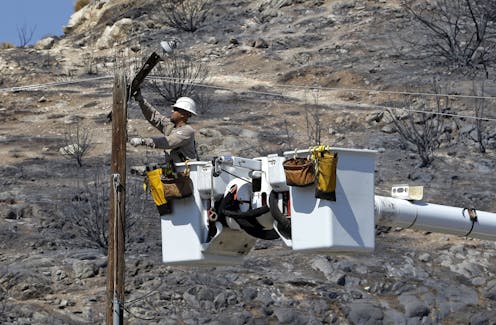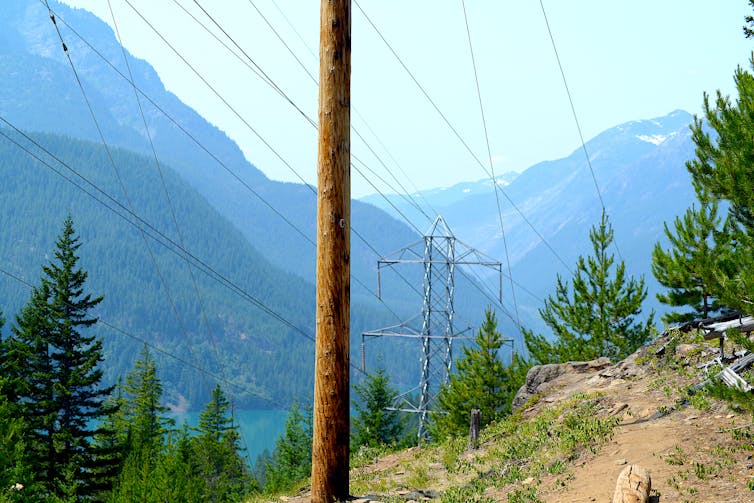Shutting off power to reduce wildfire risk on windy days isn’t a simple decision – an energy expert
Losing power also has real consequences for people’s businesses, livelihoods and potentially their health and safety.

Maui County is suing Hawaiian Electric, claiming the utility was negligent for not shutting off power as strong winds hit the island in the hours before the city of Lahaina burned. While the cause of the devastating Aug. 8, 2023, wildfire is still under investigation, forecasters had warned that powerful winds were expected, and West Maui had exceptionally dry conditions that put it at high risk for wildfires.
In many cases, however, deciding to shut off power isn’t as simple is as it might sound. We asked Tim Lieuwen, executive director of the Strategic Energy Institute at Georgia Tech, about the risks and trade-offs utilities have to weigh in deciding how to respond during fire-risk conditions.
Why are utilities so often suspected in fires?
There are a lot of ways that utility lines, particularly high-voltage lines, can spark fires.
If tree branches are too close to the lines, electricity can arc between the line and the tree. Old equipment can set off sparks. If the weather gets really hot, power lines can sag and touch dry grass or trees. If there’s a lot of wind, that can push a power line into tree branches or damage equipment.
All of those can and have been fire-starters.
In California, a state audit found that electrical power caused 10% of all wildfires and was responsible for nearly 20% of all acres burned from 2016 to 2020. Those were also some of the most destructive fires in state history – including the 2018 fire that destroyed the town of Paradise. Pacific Gas & Electric pleaded guilty to 84 counts of involuntary manslaughter in that case and one felony count of unlawfully starting a fire.
Do utilities have a responsibility for fire safety?
That’s the question at the heart of litigation and debates.
Public utilities’ obligations can vary state to state. In general, regulated utilities have a duty to provide safe, affordable, reliable power to their customers. That can mean making tough choices.
Let’s say it’s really windy, dry and hot – ideal conditions for spreading a wildfire. The utility can shut off power, but that means people don’t have air conditioning in what may be extreme heat. People with health issues – who might need oxygen, for example – might not be able to run essential medical devices.
Electricity is critical infrastructure and a foundational bedrock to many other services. Cellphone service can be lost if transmission towers lack backup power, so when power goes out in a disaster, people could lose access to crucial information. Water pumps used in wells and water treatment also need electricity. Many municipal water systems have backup generators to keep water flowing, but small water systems might not.
Texas learned about cascading dependencies during the deep freeze in February 2021. When power systems failed, the pumps used to send gas and oil through pipelines went out. That meant power plants weren’t getting the gas they needed to operate.
Utilities have to balance the risk of keeping power on with the risks created by shutting power off.
What can utilities do to manage fire risk?
Utilities can make sure they’re careful about trimming trees, cutting grasses and removing other dry fuel that can ignite near power lines.
In really high-risk areas, they can move their lines underground. There’s an effort to do that in California, but estimates show it would be prohibitively expensive to take all high-voltage lines underground.
To give you a sense of the amount of line we’re talking about, in 2021, California utilities reported having nearly 40,000 miles of bare power lines in areas at high risk of wildfires.

Utilities are constantly actively looking for fire risks, whether it’s replacing old transformers or upgrading lines that might be overloaded or clearing away foliage.
Technology also helps identify risks. Sensors can detect sparks on a power line. Newer tools being tested aim to detect variations in electrical current that could indicate overloaded lines before sparks occur. On hot days, being better able to manage the distribution of power flow of electricity through power lines that are overloaded and potentially overheating could also help avoid problems along power lines.
Another solution is making architectural changes to the electricity grid, where rather than relying on large centralized power stations with high power, long distance transmission lines, power is produced closer to the consumer, ranging from community, to neighborhood, to one’s own home.
For example, rooftop solar and community solar projects can help reduce the need to add more high-voltage transmissions lines to carry power long distances and through high-risk wildlands. The architecture of the grid is rapidly evolving as both rooftop and community solar appear.
How do utilities balance the risks?
It’s easy to oversimplify this. Every solution, every choice, has an impact. You can shut off power during windstorms and largely eliminate the fire risk from power infrastructure. But it also has real consequences for people’s businesses, livelihoods and potentially their health and safety.
As an engineer, I can advise on the risks and develop solutions to minimize those risk through better detection, better equipment and by minimizing the need for lots of electrical lines. However, how to balance those risks and, in particular, address the issue of when a utility should shut off the power, is ultimately a societal choice.
Tim C. Lieuwen serves on the Advisory Council of EPRI, as well as governing or advisory boards of Oak Ridge National Lab, Pacific Northwest National Lab, and National Renewable Energy Lab
Read These Next
How the ‘slayer rule’ might play a role in determining who will inherit wealth from Rob Reiner and h
These rules have a long history in the United States. They played a role in the notorious murders by…
The celibate, dancing Shakers were once seen as a threat to society – 250 years later, they’re part
‘The Testament of Ann Lee,’ Mona Fastvold’s 2025 film, depicts part of the long history of Shaker…
From truce in the trenches to cocktails at the consulate: How Christmas diplomacy seeks to exploit s
World leaders like to talk up peace at Christmastime. But alongside the tales of seasonal breaks in…






